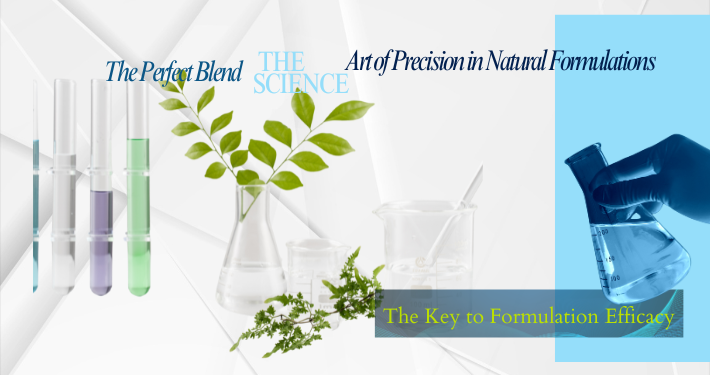24 May 2025
22 May 2025
Discover & LearnThe Perfect Blend: The Science and Art of Precision in Natural Formulations

In the world of natural beauty and wellness, the effectiveness of cold-pressed oils lies not just in their purity but in the precise alchemy of formulation. Creating a potent, stable, and skin-compatible product is not about using the most exotic ingredients—it’s about understanding how these oils work together, ensuring each fatty acid, antioxidant, and bioactive compound is present in the optimal proportion to deliver benefits without causing instability or irritation.
Unlike synthetic formulations that rely on fillers and stabilizers, cold-pressed oils are naturally bioactive. Their rich profiles—composed of fatty acids, vitamins, polyphenols, and phytochemicals—require careful balancing for effective skincare, haircare, and therapeutic applications. Overusing a certain oil may lead to oxidation, clogging, or imbalances in skin health, while underusing a key oil may reduce its efficacy.
A 2023 consumer insights report indicated that 72% of buyers prioritize “scientifically backed” claims when selecting natural beauty products. The demand for evidence-based, precisely formulated cold-pressed oil products has never been higher.
But how do formulators achieve the perfect balance? How do they optimize absorption, synergy, and stability while complying with safety regulations? This article explores the science behind correct oil proportions, examining bioavailability, synergy, stability, and regulatory compliance in natural cosmetic formulations.
1. Bioavailability: The Key to Formulation Efficacy
Each cold-pressed oil functions as a bioactive carrier, meaning its absorption and effectiveness depend on several factors:
✅ Molecular Weight – Lighter oils (e.g., grapeseed, safflower) penetrate the skin barrier quickly, while heavier oils (e.g., castor, avocado) create a protective occlusive layer.
✅ Fatty Acid Profile – High linoleic acid (Omega-6) oils, such as black seed or hemp seed oil, are ideal for oily/acne-prone skin, while high oleic acid (Omega-9) oils, such as macadamia or olive oil, benefit dry/mature skin.
✅ pH Stability – Most cold-pressed oils function optimally at a pH range of 4.5–6.5, maintaining their antioxidant and anti-inflammatory benefits.
🔬 Scientific Example:
- Rosehip oil contains provitamin A (beta-carotene), which is more stable and less photosensitizing than synthetic retinol, making it safer for daytime use.
- Mustard seed oil, when used above 20%, may overstimulate circulation, causing irritation instead of therapeutic warming.
Thus, correct percentages ensure that skin absorbs what it needs without excess waste or irritation.
2. Synergy: How the Right Ratios Enhance Performance
When blending cold-pressed oils, formulators must consider chemical synergy—how one oil interacts with another. Some oils enhance each other’s efficacy, while others may neutralize key active compounds.
✅ Optimized Oil Synergy:
- Sesame oil + Black Seed Oil (Nigella Sativa) → Sesame’s linoleic acid complements nigella’s thymoquinone, amplifying anti-inflammatory effects for eczema and acne.
- Argan oil (40%) + Fenugreek oil (5%) → Enhances hair strengthening, reducing breakage and scalp inflammation.
- Jojoba oil + Grapeseed oil (50-70%) → Ideal for facial serums due to their lightweight, fast-absorbing nature.
- Castor oil + Avocado oil + Coconut oil (10-20%) → Provides deep nourishment while preventing pore congestion.
Incorrect Synergy Risks:
- Turmeric oil (>15%) may cause unwanted yellow staining instead of brightening.
- Excess comedogenic oils (e.g., coconut oil >60%) in a facial blend can block pores, triggering acne.
- Too much black seed oil (>25%) accelerates oxidation, reducing shelf life.
- Mustard oil (>20%) can overstimulate circulation, leading to excessive warmth and skin irritation.
🔬 Scientific Example:
- Sesame oil (30%) + Black seed oil (10%) → Strong anti-inflammatory effects while keeping the formula lightweight.
- Argan oil (40%) + Fenugreek oil (5%) → Strengthens hair while preventing excess oil buildup.
3. Stability & Oxidation: The Role of Correct Ratios
Cold-pressed oils are prone to oxidation, leading to rancidity, nutrient loss, and potential irritation. The right ratios extend shelf life naturally.
✅ Preventing Oxidation Efficiently:
- Combine stable & oxidation-prone oils → Mixing 30-40% high-oleic oils (e.g., olive, macadamia) with polyunsaturated oils (e.g., black seed, evening primrose) slows degradation.
- Add antioxidants → 1-2% Vitamin E (tocopherol) helps protect fragile fatty acids.
- Use CO2 extracts → Rosemary or green tea CO2 extracts act as natural stabilizers.
Poor Stability Risks:
- Flaxseed oil (>30%) oxidizes rapidly, reducing shelf life to 3 months without stabilizers.
- High-linoleic oils (e.g., evening primrose, hemp) can go rancid within weeks if exposed to air, heat, or light.
4. Regulatory Compliance: Ensuring Safe Usage
Achieving the right balance isn’t just about performance—it’s about ensuring skin compatibility, safety, and compliance with EU Cosmetic Regulation (EC 1223/2009).
Key Regulatory Limits:
- Clove oil in leave-on products → Capped at 0.5% due to potential skin sensitization.
- Mustard oil in cosmetics → Restricted above 5% in some countries due to potential irritation.
- High menthol content oils (e.g., peppermint, wintergreen) → Can cause burning if overused.
Ignoring these limits does not make a product more natural—it makes it unsafe.
5. Avoiding Greenwashing: When “Natural” Becomes Harmful
Many brands overuse botanical extracts and oils, assuming that more is better. However, exceeding safe concentrations can lead to:
❌ Increased skin sensitivity → Excess mentholated oils cause irritation. ❌ Product instability → High-linoleic oils oxidize quickly if not stabilized.
✅ Cold-pressed oils are potent but must be carefully formulated to maintain safety, stability, and efficacy.
If you want to know how make one of the most important transformations in your life you should read this
The Art & Science of Precision
Creating effective, stable, and safe natural formulations is not just about choosing high-quality cold-pressed oils—it’s about blending them with precision. Every drop, every percentage matters.
By mastering oil ratios, formulators can:
- Maximize effectiveness while ensuring long-term stability.
- Maintain skin balance without overloading or stripping natural moisture.
- Enhance synergy between bioactive compounds while avoiding unwanted interactions.
- Extend shelf life naturally with antioxidants and stabilizers.
- Ensure optimal absorption and regulatory compliance.
🔬 Mastering natural formulation requires precision. Whether for efficacy, stability, or safety, the right oil percentages make all the difference.
.png)

.png)
.png)